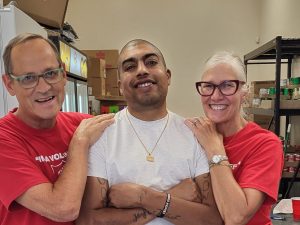The 100th Anniversary of the San Francisco Earthquake and Fire
by Judy Vaughn –
In 1906, San Francisco, with a population of 400,000, was the business center for the western mining frontiers. That year, at 5:12 a.m. on April 18, the city was jolted awake by an earthquake—now estimated at 7.9 on the Richter scale—that originated from the San Andreas Fault, a deep fissure in the earth’s crust that extends some 600 miles.
While damage from the temblor was severe, the ensuing fires were catastrophic. Killed in the quake was Fire Chief Dennis Sullivan, leaving the fire department without strong leadership at its time of greatest need.
While the official casualty count was 700, as many as 3,000 may have died, and 225,000 (over half the population) became homeless. The estimated damage was 500 million (1906 dollars)—over five billion in today’s dollars.
Judy Vaughn explores the role of The Salvation Army in the aftermath of this historic disaster.
In 1906 when The Salvation Army’s National Commander Evangeline Booth said, “San Franciscans have spirits like corks and come back with a bounce every time,” she was referring to more than just the earthquake and fire.
“Survivors,” she said, have “pluck.” In the early part of the twentieth century, that was Horatio Alger’s definition of people who never gave up. They had resilience, an understanding that no matter how devastating a disaster was, there was always hope for the future.
Salvationists—naturally optimistic as an inherent part of their faith—were part of the resilience that brought the City back to life in 1906.
All but two of the Army’s buildings in San Francisco were destroyed—Corps #4 at 24th Street and Mission and the officer’s quarters. The South of Market waterfront and workingman’s neighborhood where the Army had been most active since its arrival in 1883 was a tinderbox of matchstick wooden houses. These were the first to be consumed by flames. Once the fires spread, there was little anyone could do to help. So, in the best sense of “meeting need at point of need,” Salvationists found another way to provide service. An estimated 225,000 people were hurrying to catch the first ferries out of town. The Army determined to meet them on the opposite shore.
Colonel George French was Commander of the Army’s Southern Pacific Province. Because he lived in Oakland, he could see that thousands were fleeing the fire and he quickly arranged for services at the docks and a round-the-clock shelter at the 9th Street Citadel. His report to the Oakland Relief Committee said soldiers responded “cheerfully and, better still, immediately to the call, even at considerable loss to themselves, working as I’ve never ever seen Salvationists working before; incessantly, early and late, and yes, all night to alleviate the suffering.”
Had the refugees eaten a hot meal? Did they have more than the clothes on their backs? Did they need to be in touch with family in inland cities? Did they need help to find missing children? Reading the reports of Salvation Army services in 1906 is the same as if it were in Louisiana, Mississippi and Texas following killer hurricanes in 2005.
Eventually, the Army’s relief camp in Oakland’s Beulah Park was turned over to government officials and Salvationists turned their attention to rebuilding in San Francisco. According to French’s annual report dated September 28, 1906, the Army’s new temporary headquarters was the first on its block to be rebuilt. It was dedicated in the middle of July and included housing for working men.
Eight weeks later, Ensign Susie J. World emotionally reported to War Cry her own story of moving 12 different times in search of her brothers and sisters and, finally, sharing with her soldiers the sorrow of losing the #1 corps building but not its spirit.
A year later, Staff Captain Bill Day, who had run the Beulah Relief Camp, reminisced about the good which had hopefully emerged from the disaster. In the midst of horrendous upheaval and uncertainty, people had reached out to each other. They had found an “indomitable spirit of dauntless grit” such that one man could advertise his assets boldly:
Cash $17.35
Reputation 30
Energies 100,000.00
Possibilities 100,000.00
1 suit clothes
Fixtures 2 white vests
1 plug hat, slightly damaged 15.00
Total $100,032.65
“San Franciscans are a plucky people,” reported
Day. “Since the hour of their misfortune they have
never found time to pine or whine, moan or groan.”
Judy Vaughn recently retired as public relations director
for the Golden State Division. Her book, The Bells of
San Francisco—The Salvation Army with its Sleeves
Rolled Up, is available from the
division at 1-800-944-9677, and at
www. barnesandnoble.com and
www.borders.com.












